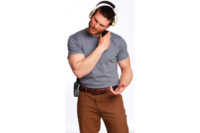
Two-way communication is essential in emergency response activities.
Business and personal daily events rely on communication in so many ways that we insist on instant and efficient voice and data transfer from one corner of the world to the next. Even our children demand immediate communication with their cell phones and texting devices and parents support their demands on the premise of safety and security.
By contrast, two-way communications in industry have huge “gaps in service” created by high noise and use of PPE such as respirator devices, hearing protection and protective clothing. These PPE can degrade or prevent the use of two-way communication devices and thus affect safety, security and company profits.
In the most volatile work environments, it is not uncommon to see workers remove their hearing protection and even their respirator to attempt to use their two-way radio. The desire to communicate is greater than the traditional radio’s ability to function in high noise or with mandatory PPE. Because these barriers exist, communication is difficult at best and PPE effectiveness can be compromised, resulting in employee exposure and gaps in communication.
A lot of time and valuable resources are wasted trying to locate workers, request assistance at a job task or communicate work status or warnings to others. When a routine task changes and demands immediate attention, hand signals just do not cut it. In a crisis, a breakdown in communication, can mean loss of profit, limb or life.
Emergency responders claim that poor radio communication is one of the most serious issues in dealing with efficient response. Use of the two-way radio is complicated by respirator use, hearing protection and often Level A suits. Thus, responders can be completely out of communication, contributing to higher anxiety and longer times to resolve the problem.
Shopping for a solution
Certainly price is a consideration, but it should not a deal-breaker. Your best investment will be to buy a system that will enable immediate communication for even your most difficult work areas and PPE use. If it works for the most difficult areas and operations, you will get your investment back quickly.
Here is a “shopping list” of demands to consider as you explore options to improve your safety, security and profitability through immediate two-way communication. The system:
- Will not sacrifice clear communication in high noise;
- Provides hearing protection at least as good as traditional passive HPDs;
- Will not present dangerously loud listening levels to the user’s ear;
- Enables full two-way communication without removing the respirator;
- Can be comfortably worn for a full work shift if necessary;
- Can be repaired and returned to use quickly and inexpensively;
- Is capable of an accurate “fit test” to check for hearing protection;
- Will work with your existing radio system.
- Headsets
- Single-ear listen-only ear “bud’s” + speaker mic
- Dual-ear talk + listen ear pieces + speaker mic
- Bone or throat mic’s using a listen-only ear bud
- Near field voice amplification with an amplified external speaker
- Dual-ear talk + listen-ear pieces + speaker mic
There are solutions for common communication situations and there are applications for each type of system. Many products will address one problem but not others. Defining your needs and sticking to your “shopping list” demands will help in selecting the communication accessory to address all your company’s business needs.
If your operations require the most stringent PPE and compliance, i.e. hearing protection, safety glasses, bump caps, respirators, radios and even protective suits, then your options in selecting a dependable communication accessory will be more challenging. Keep looking until you find an acceptable solution to your specific needs and one that the operators will wear and use consistently.
